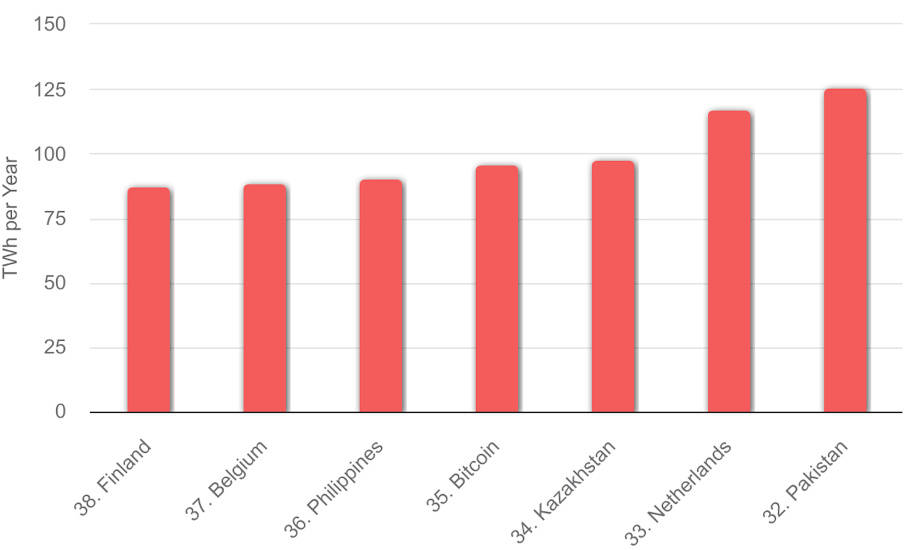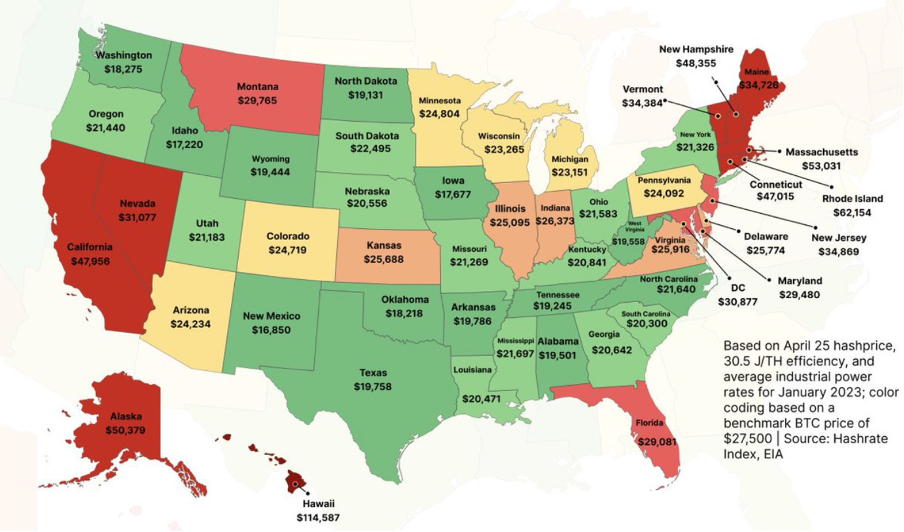The rising electricity rates in the United States have increased Bitcoin mining costs. As the electricity demand grows and expenses increase, Bitcoin miners face higher operating costs, reducing their profit margins.
Electricity is a crucial factor in the process of Bitcoin mining, which is the process of verifying transactions and adding them to the blockchain. As the Bitcoin network grows, so does the demand for electricity to power the mining process. The rising electricity rates in the United States have contributed to the increasing Bitcoin mining costs, making it less profitable for miners.
SponsoredEnergy Usage Across the Globe
The cost of electricity is a leading expense for Bitcoin miners, as the mining process requires a vast amount of energy. The Bitcoin Energy Consumption Index estimates that the Bitcoin network consumes more energy than the entire country of the Philippines. The electricity consumption is primarily driven by the need to power the specialized computer equipment used in the mining process, which requires vast energy.

The cost of electricity varies markedly across different states in the United States, with some having substantially higher electricity rates than others. For example, in Hawaii, the average residential electricity rate is around 30 cents per kilowatt hour, more than double the national average of about 13 cents per kilowatt hour. In contrast, states such as Washington and Louisiana have some of the lowest rates in the country, with average rates of around 8 cents per kilowatt-hour.
The higher electricity rates in some states have made it less profitable for Bitcoin miners to operate there. This is because the higher electricity costs raise the overall mining cost, eating into miners’ profits. As a result, some miners have had to shut down their operations or relocate to areas with lower electricity rates to stay profitable.
Another factor contributing to the rising electricity rates is the surge in electricity demand. As the population grows and more people use electricity, the need increases, driving up the cost. This increased demand has been particularly evident in places such as California, where the population has proliferated, leading to a strain on the state’s power grid and causing rolling blackouts.
Questioning the Sustainability Approach
The rising electricity rates have also led to concerns about the environmental impact of Bitcoin mining. As the Bitcoin network’s energy consumption grows, so does the carbon footprint of the mining process. This has led to criticisms of Bitcoin mining as an environmentally unsustainable practice, with some calling for more sustainable mining practices or a shift to alternative cryptocurrencies that are less energy-intensive.
Sponsored SponsoredTo address these concerns, some Bitcoin miners have explored alternative energy sources, such as solar and wind power. By using renewable energy sources, miners can reduce their carbon footprint and potentially lower their overall electricity costs in areas where renewable energy is cheaper than traditional sources. However, using renewable sources for Bitcoin mining is still rare, and most miners rely on conventional energy sources such as coal and natural gas.
In addition to the rising electricity rates, other factors drive the increasing Bitcoin mining costs. These include the cost of specialized computer equipment, the difficulty of the mining process, and the price of Bitcoin itself. As prices fluctuate, so does the profitability of mining, and miners must continually adapt to changing market conditions to stay profitable.
Where Things Stand
In 2023, the electricity rate continues to reach new highs, which doesn’t come as a surprise. Bitcoin miners require at least $17,000 to produce one BTC in the United States versus the $5,000 to 10,000 range a year ago. This is according to the Bitcoin mining data resource Hashrate Index and Luxor.
From January 2022 to January 2023, the commercial electricity tariff surged at an average of 10.71% per US state. This is higher than the average consumer price index surge of 6.40%.

In addition, a relatively poor performance from the most prominent digital asset last year led to miners taking heavy losses. Mainly due to the increase in operational costs and lower returns.
Although Q1 2023 did see a change in the scenario. Bitcoin hashrate has been trending upwards from 2022 lows. According to data from CoinWarz, the latest BTC hashrate is 382.16 EH/s. This year, it recorded a new high of 296.8 EH/s on May 1. Mining companies, too, recorded a surge in their stocks as the market tried to recover.
Best to Worst State to Mine Bitcoin
Compiling all the insights from above, different geographic regions in the US have differing outcomes.
New Mexico has relatively cheap electricity prices, making it one of the more affordable states for Bitcoin mining. Per the Hashrate index report, New Mexico emerged as the most reasonable and, in turn, more profitable state for Bitcoin miners in Q1 at $16,850 to mint one BTC.
Sponsored Sponsored
On the other hand, Hawaii has some of the highest electricity prices in the United States due to its isolated location and reliance on imported oil for power generation. Thus, Hawaii was the most expensive at around $114,590.
Some states undertook steps to protect miners from censure around the energy usage critics have faced over the years. Nonetheless, mining operations have taken a greener path to offset carbon footprints. In fact, the World Economic Forum (WEF) praised Bitcoin mining as one of the avenues for reducing emissions.
Boosting Profitability
Overall, miners have witnessed ups and downs during their journey to mine Bitcoin. Energy deflation, or a decrease in the cost of energy, could boost miners’ profitability in the short term by reducing one of the most significant costs of Bitcoin mining: electricity. If energy prices decline, miners can use the same amount of energy to mine more Bitcoin, increasing their profit margins.
However, it’s important to note that energy deflation could also lead to increased competition in the mining industry. Lower energy costs make it more affordable for more people to mine Bitcoin. This could increase the hash rate, making it more difficult and expensive for individual miners to compete.
Furthermore, energy prices can be volatile and subject to geopolitical and market factors. While energy deflation may benefit miners in the short term, it’s essential to consider the long-term sustainability and viability of Bitcoin mining operations in the face of potential energy cost fluctuations.

